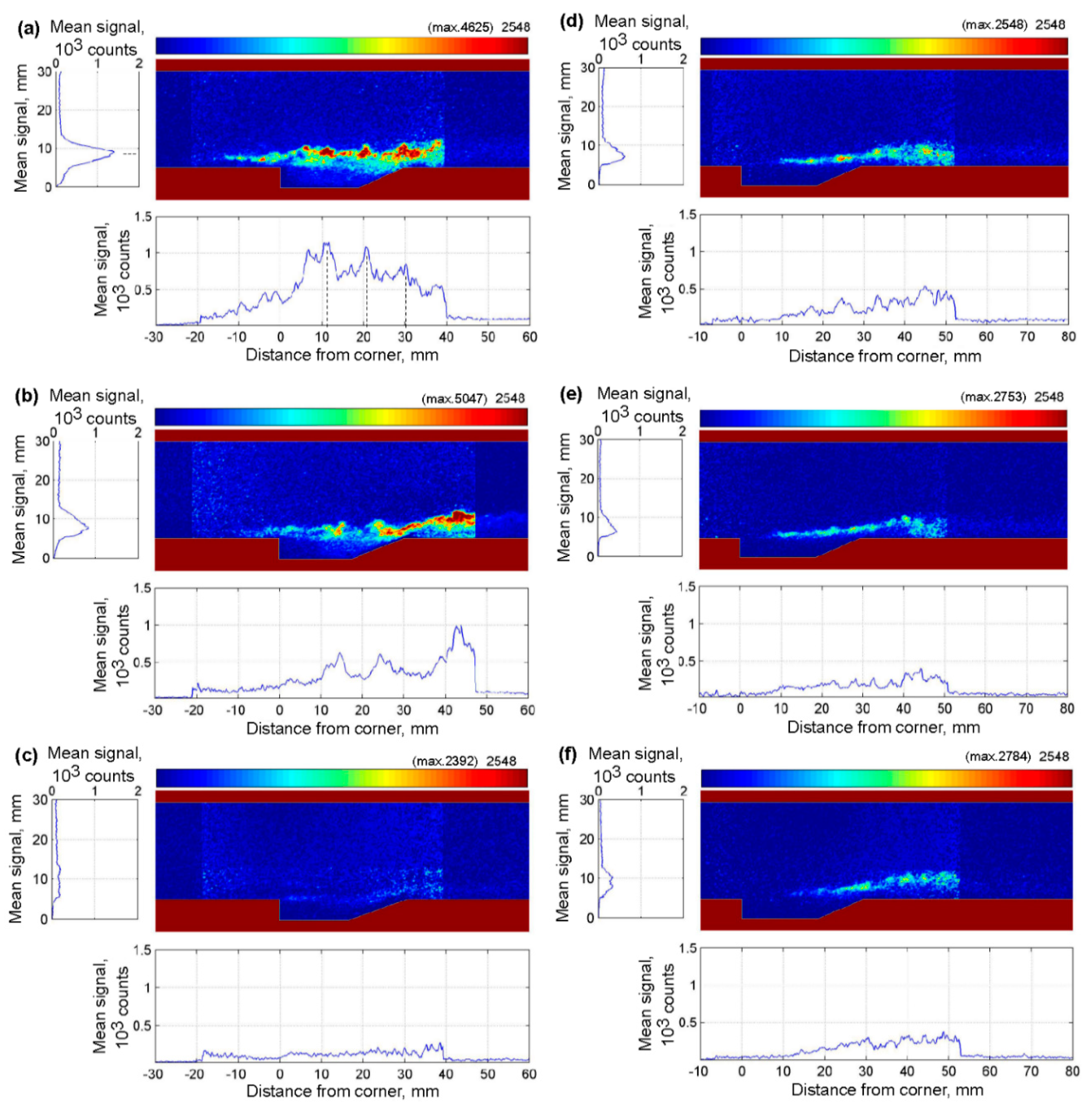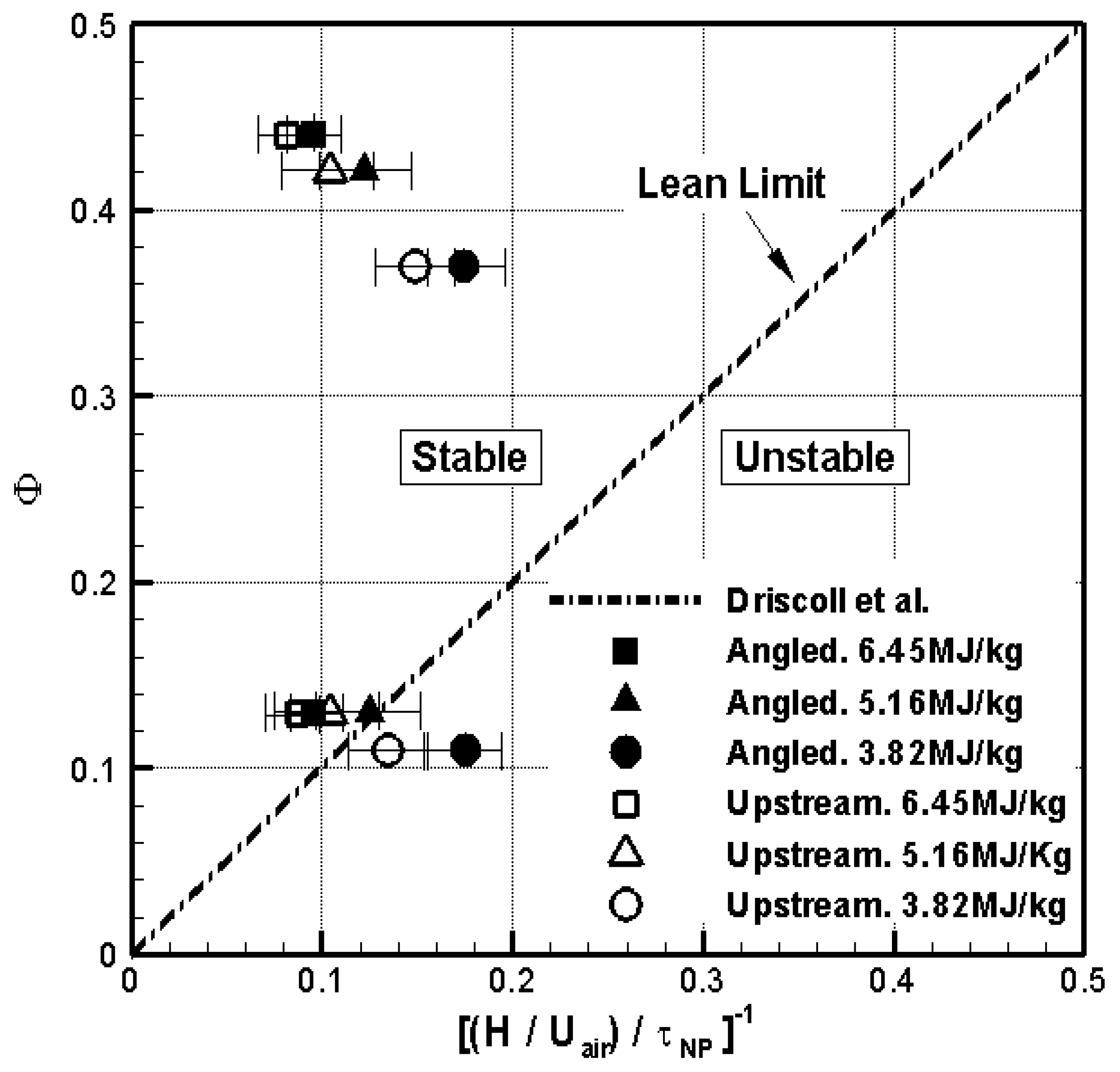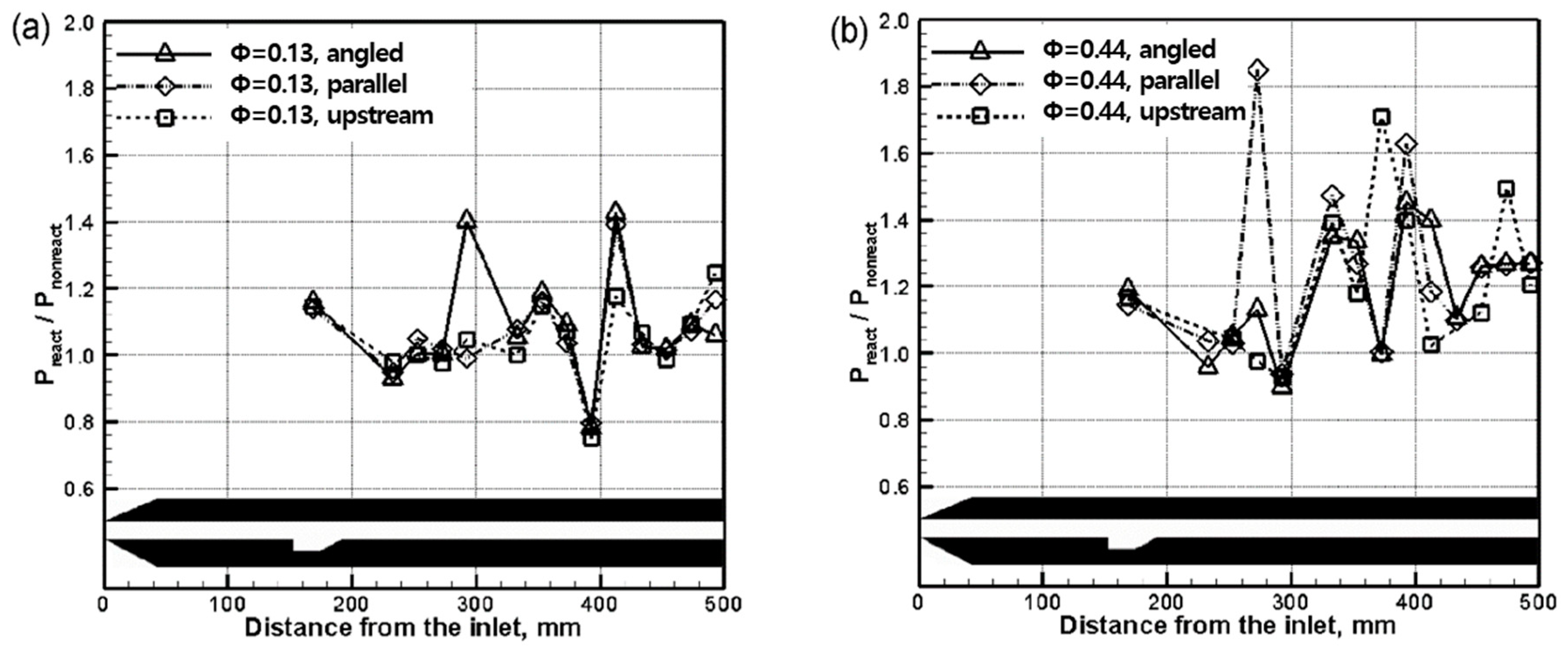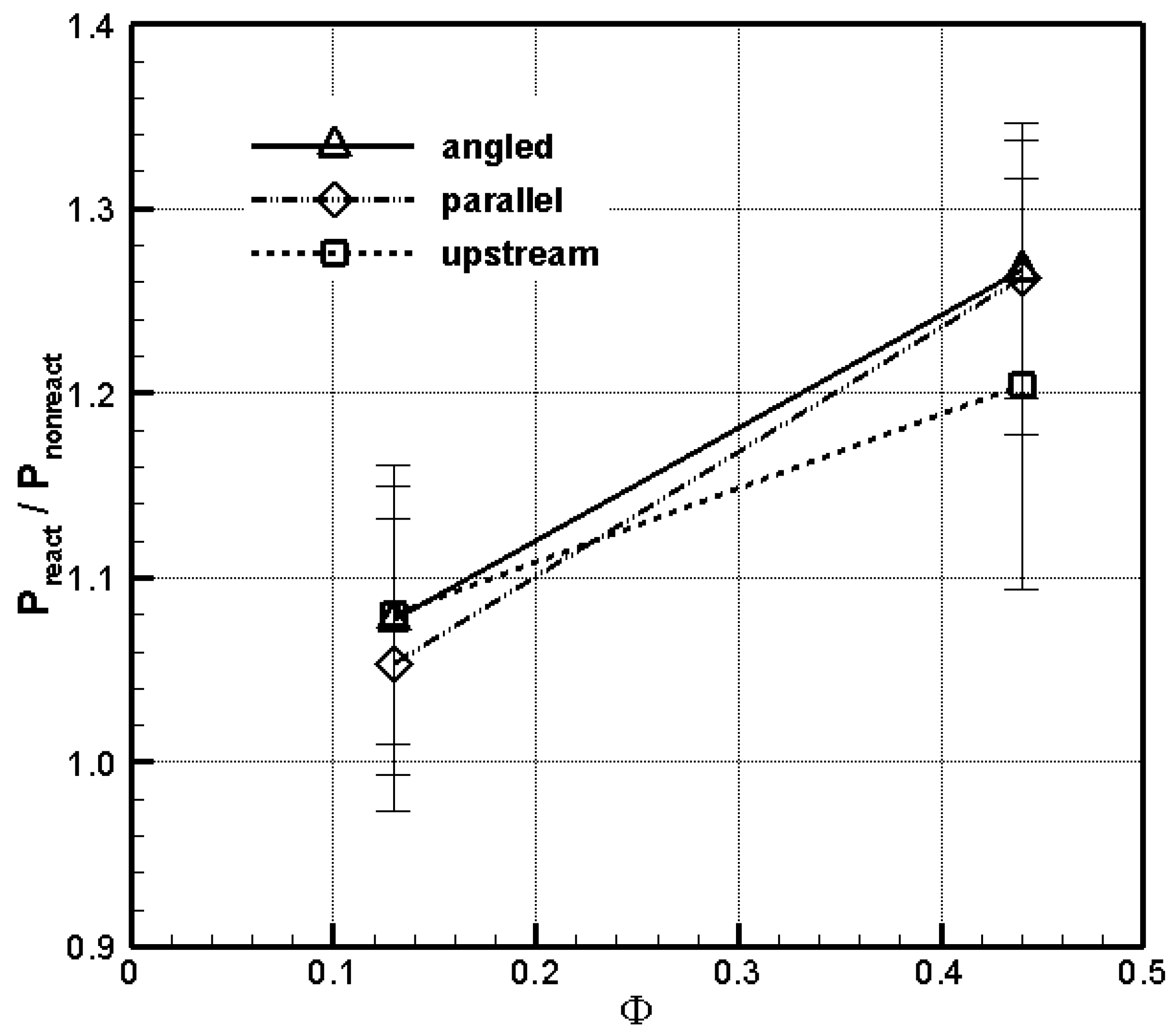The Effect of Fuel Injection Location on Supersonic Hydrogen Combustion in a Cavity-Based Model Scramjet Combustor †
Abstract
:1. Introduction
2. Experimental Arrangement
2.1. Cavity-Based Model Scramjet Combustor
2.2. Free-Piston Shock Tunnel and Flow Conditions
3. Results
3.1. OH PLIF Imaging
3.2. Pressure Measurements
4. Conclusions
- (1)
- Angled fuel injection had greater fuel penetration into the air flow and enhanced both diffusion amongst the two gases and flow temperature. As the equivalence ratio increased, angled injection generated a weak bow shock in front of the injector and a recirculation zone to hold the flame. Parallel fuel injection started the ignition at the midpoint in the cavity and produced supersonic combustion only along the shear layer. For the high equivalence ratio condition, the supersonic flame developed along a single line according to the cavity geometry in the vertical section. Most of the fuel moved downstream along the bottom wall of the combustor and was not mixed actively with the air in the cavity. Therefore, the cavity inside did not hold the flame. Upstream injection showed similar flame structures to parallel injection at low equivalence ratio. However, for the high equivalence ratio condition, the fuel, which was injected in the opposite direction of air inflow with high injection pressure, impacted against the cavity’s leading edge, thus enhancing the fuel diffusion and enabling more rapid ignition. The existence of supersonic combustion near the cavity depended on the fuel injection location for the lower equivalence ratio and lower total enthalpy of air flow. The flame characteristics agreed with the correlation plot of the stable flame limit for the non-premixed condition, as defined by Driscoll and Rasmussen [26]. Using this correlation appeared to remain valid at high flight Mach number, and the plot enabled us choose combustion conditions within the stable flame limit.
- (2)
- For low equivalence ratio, all three injection methods for non-reacting and reacting flows showed similar pressure distributions in the combustor, except within the cavity. For reacting flows of high equivalence ratio, there were conspicuous pressure rises from x = 293 mm due to heat release by combustion for all three all injection configurations. Pressure in the cavity increased, in descending order, using angled, upstream, and parallel injection, provided the equivalence ratio was the same for the three cases. Parallel and upstream injection methods increased the cavity pressure monotonically with increasing equivalence ratio, whereas the cavity pressure of angled injection was less influenced by injection pressure. However, the pressure ratio of the cavity for reacting flows compared with non-reacting flows was around 18% for all fuel injection types and equivalence ratios.
- (3)
- All fuel injection types indicated similar combustion effects in the combustor and had almost unity value for the low equivalence ratio condition. At x = 293 mm behind the combustor, pressure ratios of reacting flows to non-reacting flows increased beyond unity; therefore, rising temperatures and enhanced fuel-air mixing by shock reflection increased the generation of supersonic combustion. As the equivalence ratio increased, this phenomenon appeared more pronounced.
- (4)
- Behind the oblique shock reflection on the combustor bottom wall, the averaged pressure ratios for low equivalence ratio were similar for all three injection methods. However, upstream injection was 5% lower than the other methods for the high equivalence ratio condition.
Author Contributions
Funding
Acknowledgments
Conflicts of Interest
Nomenclature
| L | length of the cavity |
| D | depth of the cavity |
| ushock | primary shock speed |
| h0 | total enthalpy of nozzle reservoir |
| p | pressure |
| T | temperature |
| ρ | density |
| u | velocity |
| M | Mach number |
| Φ | global equivalence ratio |
| DaNP | Damköhler number for non-premixed flow |
| H | step height |
| UA | velocity of air side of shear layer |
| τNP | characteristic flame timescale for non-premixed flow |
| Subscripts | |
| o | stagnation condition |
| ∞ | freestream condition |
| e | combustor entrance condition |
References
- Everett, D.E.; Woodmansee, M.A.; Dutton, J.C.; Morris, M.J. Wall Pressure Measurements for a Sonic Jet Injected Transversely into a Supersonic Crossflow. J. Propuls. Power 1998, 14, 861–868. [Google Scholar] [CrossRef]
- VanLerberghe, W.M.; Santiago, J.G.; Dutton, J.C.; Lucht, R.P. Mixing of a Sonic Transverse Jet Injected into a Supersonic Flow. AIAA J. 2000, 38, 470–479. [Google Scholar] [CrossRef]
- Ben-Yakar, A.; Hanson, R.K. Experimental Investigation of Flame-Holding Capability of Hydrogen Transverse Jet in Supersonic Cross-Flow. In Twenty-Seventh International Symposium on Combustion; The Combustion Institute: Pittsburgh, PA, USA, 1998; pp. 2173–2180. [Google Scholar]
- Ben-Yakar, A.; Hanson, R.K. Cavity Flame-Holders for Ignition and Flame Stabilization in Scramjets: An Overview. J. Propuls. Power 2001, 17, 869–877. [Google Scholar] [CrossRef]
- Gruber, M.R.; Nejad, A.S.; Goss, L.P. Surface Pressure Measurements in Supersonic Transverse Injection Flowfields. In Proceedings of the 33rd AIAA/ASME/SAE/ASEE Joint Propulsion Conference & Exhibit, Seattle, WA, USA, 6–9 July 1997. [Google Scholar]
- Berman, H.A.; Anderson, J.D., Jr.; Drummond, J.P. Supersonic Flow over a Rearward Facing Step with Transverse Nonreacting Hydrogen Injection. AIAA J. 1983, 21, 1707–1713. [Google Scholar] [CrossRef]
- Abbitt, J.D.; Segal, C.; McDaniel, J.C.; Krauss, A.H.; Whitehurst, R.B. Experimental Supersonic Hydrogen Combustion Employing Staged Injection Behind a Rearward-Facing Step. J. Propuls. Power 1993, 9, 472–478. [Google Scholar] [CrossRef]
- Kuratani, N.; Ikeda, Y.; Nakajima, T.; Tomioka, S.; Mitani, T. Mixing Characteristics of Normal Injection into a Supersonic Backward-Facing Step Flow Measured with PIV. In Proceedings of the 40th AIAA Aerospace Sciences Meeting & Exhibit, Reno, NV, USA, 14–17 January 2002. [Google Scholar]
- Ikeda, Y.; Kuratani, N.; Nakajima, T.; Tomioka, S.; Mitani, T. M2.5 Supersonic PIV Measurements in a Backward-Facing Step Flow with Normal Injection. In Proceedings of the 40th AIAA Aerospace Sciences Meeting & Exhibit, Reno, NV, USA, 14–17 January 2002. [Google Scholar]
- Hartfield, R.J.; Hollo, S.D.; McDaniel, J.C. Experimental Investigation of a Supersonic Swept Ramp Injector Using Laser-Induced Iodine Fluorescence. J. Propuls. Power 1994, 10, 129–135. [Google Scholar] [CrossRef]
- Fuller, R.P.; Wu, P.K.; Nejad, A.S.; Schetz, J.A. Comparison of Physical and Aerodynamic Ramps as Fuel Injectors in Supersonic Flow. J. Propuls. Power 1998, 14, 135–145. [Google Scholar] [CrossRef]
- Riggins, D.W.; McClinton, C.R.; Rogers, R.C.; Bittner, R.D. Investigation of Scramjet Injection Strategies for High Mach Number Flows. J. Propuls. Power 1995, 11, 409–418. [Google Scholar] [CrossRef]
- Riggins, D.W.; Vitt, P.H. Vortex Generation and Mixing in Three-Dimensional Supersonic Combustors. J. Propuls. Power 1995, 11, 419–426. [Google Scholar] [CrossRef]
- Donohue, J.M.; McDaniel, J.C. Complete Three-Dimensional Multiparameter Mapping of a Supersonic Ramp Fuel Injector Flowfield. AIAA J. 1996, 34, 455–462. [Google Scholar] [CrossRef]
- Seiner, J.M.; Dash, S.M.; Kenzakowski, D.C. Historical Survey on Enhanced Mixing in Scramjet Engines. J. Propuls. Power 2001, 17, 1273–1286. [Google Scholar] [CrossRef]
- Fox, J.S.; Houwing, A.F.P.; Danehy, P.M.; Gaston, M.J.; Mudford, N.R.; Gai, S.L. Mole-Fraction-Sensitive Imaging of Hypermixing Shear Layers. J. Propuls. Power 2001, 17, 284–292. [Google Scholar] [CrossRef]
- Yu, K.H.; Wilson, K.J.; Schadow, K.C. Effect of Flame-Holding Cavities on Supersonic-Combustion Performance. J. Propuls. Power 2001, 17, 1287–1295. [Google Scholar] [CrossRef]
- Gruber, M.R.; Donbar, J.M.; Carter, C.D.; Hsu, K.-Y. Mixing and Combustion Studies Using Cavity-Based Flameholders in a Supersonic Flow. J. Propuls. Power 2004, 20, 769–778. [Google Scholar] [CrossRef]
- Rasmussen, C.C.; Driscoll, J.F.; Carter, C.D.; Hsu, K.Y. Characteristics of Cavity-Stabilized Flames in a Supersonic Flow. J. Propuls. Power 2005, 21, 765–768. [Google Scholar] [CrossRef]
- O’Byrne, S.; Stotz, I.; Neely, A.J.; Boyce, R.R.; Mudford, N.R.; Houwing, A.F.P. OH PLIF Imaging of Supersonic Combustion using Cavity Injection. In Proceedings of the AIAA/CIRA 13th International Space Planes and Hypersonics Systems and Technologies Conference, Capua, Italy, 16–20 May 2005. [Google Scholar]
- Neely, A.J.; Stotz, I.; O’Byrne, S.; Boyce, R.R.; Mudford, N.R.; Houwing, A.F.P. Flow Studies on a Hydrogen-Fueled Cavity Flame-Holder Scramjet. In Proceedings of the AIAA/CIRA 13th International Space Planes and Hypersonics Systems and Technologies Conference, Capua, Italy, 16–20 May 2005. [Google Scholar]
- Rasmussen, C.C.; Dhanuka, S.K.; Driscoll, J.F. Visualization of Flameholding Mechanisms in a Supersonic Combustor using PLIF. Proc. Combust. Inst. 2007, 31, 2505–2512. [Google Scholar] [CrossRef]
- Lin, K.; Tam, C.; Boxx, I.; Carter, C.; Jackson, K.; Lindsey, M. Flame Characteristics and Fuel Entrainment Inside a Cavity Flame Holder of a Scramjet Combustor. In Proceedings of the 43rd AIAA/ASME/SAE/ASEE Joint Propulsion Conference & Exhibit, Cincinnati, OH, USA, 8–11 July 2007. [Google Scholar]
- Ebrahimi, H.; Gaitonde, D.V.; Malo-Molina, F.J. Parametric Study of 3-D Hydrocarbon Scramjet Engine with Cavity. In Proceedings of the 45th AIAA Aerospace Sciences Meeting and Exhibit, Reno, NV, USA, 8–11 January 2007. [Google Scholar]
- Jeong, E.; O’Byrne, S.; Jeung, I.-S.; Houwing, A.F.P. Investigation of Supersonic Combustion with Angled Injection in a Cavity-Based Combustor. J. Propuls. Power 2008, 24, 1258–1268. [Google Scholar] [CrossRef]
- Driscoll, J.F.; Rasmussen, C.C. Correlation and Analysis of Blowout Limits of Flames in High-Speed Airflows. J. Propuls. Power 2005, 21, 1035–1044. [Google Scholar] [CrossRef]
- Seitzman, J.M.; Hanson, R.K. Comparison of Excitation Techniques for Quantitative Fluorescence Imaging of Reacting Flows. AIAA J. 1993, 31, 513–519. [Google Scholar] [CrossRef]
- McIntosh, M.K. Computer Program for the Numerical Calculation of Frozen Equilibrium Conditions in Shock Tunnels; Technical Report; Australian National University: Canberra, Australia, 1968. [Google Scholar]
- Vardavas, I.M. Modelling Reactive Gas Flows within Shock Tunnels. Aust. J. Phys. 1984, 37, 157–177. [Google Scholar] [CrossRef] [Green Version]
- O’Byrne, S. Examination of Transient Mixing and Combustion Processes in a Supersonic Combustion Ramjet Engine. Master’s Thesis, Department of Physics, Australian National University, Canberra, Australia, 1997. [Google Scholar]
- Baxter, M.R.; Lefebvre, A.H. Flame Stabilization in High-Velocity Heterogeneous Fuel-Air Mixtures. J. Propuls. Power 1992, 8, 1138–1143. [Google Scholar] [CrossRef]
- Plee, S.L.; Mellor, A.M. Characteristic Time Correlation for Lean Blowoff of Bluff-Body Stabilized Flames. Combust. Flame 1979, 35, 61–80. [Google Scholar] [CrossRef]
- Zukoski, E.E.; Marble, F.E. Experiments Concerning the Mechanism of Flame Blowoff from Bluff Bodies; Proceedings of the Gas Dynamics Symposium on Thermochemistry; Northwestern University: Evanston, IL, USA, 1956; pp. 205–210. [Google Scholar]
- Ozawa, R.I. Survey of Basic Data on Flame Stabilization and Propagation for High Speed Combustion Systems; U.S. AirForce, AFAPL Technical Report; TR-70-81 Wright-Patterson AFB: Wright-Patterson, OH, USA, 1971. [Google Scholar]








| Shock Tube Fill Pressure, kPa | ushock, km/s | h0, MJ/kg | p0, MPa | T0, K |
|---|---|---|---|---|
| 50 | 2.57 ± 0.03 | 6.45 ± 0.14 | 15.7 ± 0.7 | 4422 ± 60 |
| 75 | 2.36 ± 0.03 | 5.16 ± 0.03 | 15.0 ± 0.5 | 3855 ± 20 |
| 125 | 2.04 ± 0.01 | 3.82 ± 0.06 | 15.4 ± 0.6 | 3087 ± 40 |
| h0, MJ/kg | Pe, kPa | Te, K | pe, kg/m3 | ue, m/s | Me |
|---|---|---|---|---|---|
| 6.45 | 111 ± 7 | 1667 ± 60 | 0.23 ± 0.01 | 2952 ± 30 | 3.71 ± 0.03 |
| 5.16 | 100 ± 4 | 1280 ± 10 | 0.27 ± 0.01 | 2680 ± 10 | 3.83 ± 0.01 |
| 3.82 | 92 ± 4 | 899 ± 20 | 0.35 ± 0.01 | 2347 ± 20 | 3.97 ± 0.01 |
| Fuel Fill Pressure, kPa | Fuel Plenum Pressure, kPa | Fuel Injection Pressure, kPa | Equivalence Ratio | ||
|---|---|---|---|---|---|
| h0 = 6.45 MJ/kg | h0 = 5.16 MJ/kg | h0 = 3.82 MJ/kg | |||
| 900 | 631 ± 21 | 333 ± 11 | 0.13 | 0.13 | 0.11 |
| 2500 | 1906 ± 33 | 1005 ± 18 | 0.44 | 0.42 | 0.37 |
© 2020 by the authors. Licensee MDPI, Basel, Switzerland. This article is an open access article distributed under the terms and conditions of the Creative Commons Attribution (CC BY) license (http://creativecommons.org/licenses/by/4.0/).
Share and Cite
Jeong, E.; O’Byrne, S.; Jeung, I.-S.; Houwing, A.F.P. The Effect of Fuel Injection Location on Supersonic Hydrogen Combustion in a Cavity-Based Model Scramjet Combustor. Energies 2020, 13, 193. https://doi.org/10.3390/en13010193
Jeong E, O’Byrne S, Jeung I-S, Houwing AFP. The Effect of Fuel Injection Location on Supersonic Hydrogen Combustion in a Cavity-Based Model Scramjet Combustor. Energies. 2020; 13(1):193. https://doi.org/10.3390/en13010193
Chicago/Turabian StyleJeong, Eunju, Sean O’Byrne, In-Seuck Jeung, and A. F. P. Houwing. 2020. "The Effect of Fuel Injection Location on Supersonic Hydrogen Combustion in a Cavity-Based Model Scramjet Combustor" Energies 13, no. 1: 193. https://doi.org/10.3390/en13010193
APA StyleJeong, E., O’Byrne, S., Jeung, I.-S., & Houwing, A. F. P. (2020). The Effect of Fuel Injection Location on Supersonic Hydrogen Combustion in a Cavity-Based Model Scramjet Combustor. Energies, 13(1), 193. https://doi.org/10.3390/en13010193






